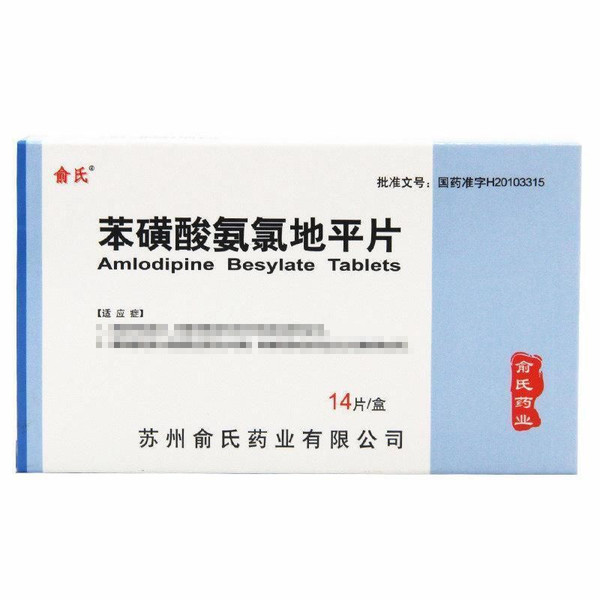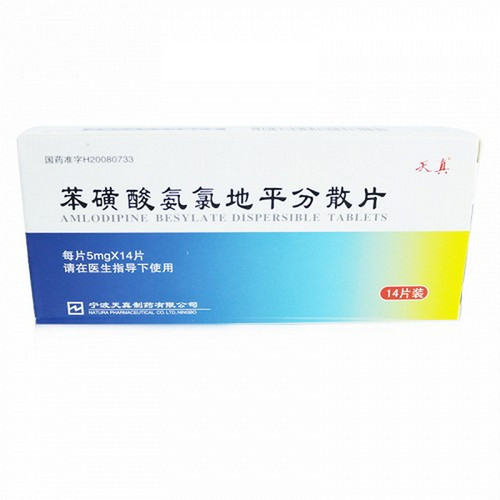Product Overview
[Drug Name]
Generic Name: Amlodipine Besylate Tablets
Trade Name: Yushi Amlodipine Besylate Tablets 5mg*14 Tablets
Pinyin Full Code: YuShi BenHuangSuanAnLvDiPingPian 5mg*14 Tablets
[Main Ingredient]
The main ingredient of this product is amlodipine besylate.
[Appearance]
This product is white tablets.
[Indications/Main Functions]
1. Essential hypertension, used alone or in combination with other antihypertensive drugs. 2. Chronic stable angina and variant angina, used alone or in combination with other antihypertensive drugs.
[Specifications]
5mg*14 tablets
[Dosage and Administration]
The usual starting oral dose is 5mg once daily, with a maximum of 10mg once daily. Patients with reduced physical fitness, elderly patients, or those with impaired liver function should begin with 2.5mg once daily. Patients taking other antihypertensive medications should also begin with this dose. The dosage should be adjusted based on individual needs, with a minimum adjustment period of 7-14 days to allow the physician to fully assess the patient's response. However, faster adjustment may be used if clinically warranted. The recommended dose for treating angina pectoris is 5-10mg. Patients aged 18 years or with impaired liver function should reduce the dose.
[Adverse Reactions]
Comparatively comprehensive safety data for this drug have been obtained from clinical studies in the United States and other countries, involving over 1,100 patients. Overall, patients tolerated the drug well at doses up to 10 mg per day. Adverse reactions reported during treatment with this drug were mostly mild or moderate. The most common side effects were headache and edema. 1. Cardiovascular System: Arrhythmias (including ventricular tachycardia and atrial fibrillation), bradycardia, chest pain, hypotension, peripheral ischemia, syncope, tachycardia, postural dizziness, postural hypotension, Vasculitis. 2. Central and Peripheral Nervous System: Hypoesthesia, peripheral neuropathy, paresthesia, tremor, vertigo. 3. Gastrointestinal System: Loss of appetite, constipation, indigestion, dysphagia, diarrhea, flatulence, pancreatitis, vomiting, gingival hyperplasia. 4. Systemic: Allergic reactions, fatigue, back pain, hot flashes, malaise, pain, stiffness, weight gain, weight loss. 5. Musculoskeletal System: Arthralgia, arthritis, muscle cramps, myalgia. 6. Psychiatric: Sexual dysfunction (male and female), insomnia, nervousness, depression, abnormal dreams, anxiety, personality disorders. 7. Respiratory distress Respiratory System: Dyspnea, epistaxis. 8. Skin and Appendages: Angioedema, erythema multiforme, pruritus, rash, erythematous rash, maculopapular rash. 9. Special Senses: Visual disturbances, conjunctivitis, diplopia, eye pain, tinnitus. 10. Urinary System: Frequent urination, abnormal urination, nocturia. 11. Autonomic Nervous System: Dry mouth, excessive sweating. 12. Nutritional Metabolism: Hyperglycemia, thirst. 13. Hematopoietic System: Leukopenia, purpura, thrombocytopenia. In placebo-controlled studies, the incidence of these events was less than 1%, but in all multiple-dose studies, the incidence of these side effects was between 1% and 2%.
[Contraindicated Contraindications]
This product is contraindicated in patients allergic to dihydropyridines or any of its ingredients.
[Drug Interactions]
1. Cimetidine, grapefruit juice, and acidogens: Coadministration does not alter the pharmacokinetics of this product. 2. Atorvastatin, digoxin, and ethanol: This product does not affect their pharmacokinetics. 3. Sildenafil: Single-dose sildenafil (Viagra?) has no effect on the pharmacokinetics of this product in patients with essential hypertension. The two drugs produce an independent antihypertensive effect when used together. 4. Warfarin: This product does not alter the prothrombin action time of warfarin. 5. Digoxin, phenytoin, and warfarin: Coadministration with this product may have an adverse effect on blood pressure. There is no effect on plasma protein binding. 6. Anesthetics: Inhaled hydrocarbons combined with this drug may cause hypotension. 7. Nonsteroidal anti-inflammatory drugs: Indomethacin, in particular, may weaken the antihypertensive effect of this drug. 8. Estrogens: Combined use may cause fluid retention and increase blood pressure. 9. Sulfinpyrazone: Combined use may increase protein binding of this drug, resulting in changes in blood concentrations. 10. Lithium: Combined use may cause neurotoxicity, resulting in nausea, vomiting, diarrhea, ataxia, tremor, and/or numbness; caution is advised. 11. Sympathomimetic amines: May weaken the antihypertensive effect of this drug.
[Precautions]
1. Angina pectoris and/or myocardial infarction: Rare Patients with severe obstructive coronary artery disease may experience an increase in the frequency, duration, and/or severity of angina attacks, or the development of acute myocardial infarction, when initiating or increasing the dose of calcium channel blockers. The mechanism is unknown. 2. Hypotension: Because this drug gradually exerts its vasodilatory effect, acute hypotension is rarely seen with oral administration. However, caution should be exercised when using this drug in combination with other peripheral vasodilators, especially in patients with severe aortic stenosis. 3. Patients with heart failure: Calcium channel blockers should be used with caution in patients with heart failure. 4. Patients with hepatic impairment: This drug should be used with caution in patients with severe hepatic impairment. 5. Patients with renal failure: The starting dose for patients with renal failure can remain unchanged. 6. This product can be used safely in patients with obstructive pulmonary disease, well-compensated heart failure, peripheral vascular disease, diabetes, and lipid disorders.
[Pediatric Use]
The recommended dose of this product for hypertensive children aged 6 to 17 years is 2.5 mg to 5 mg once daily. There are no studies on the use of this product in children with daily doses exceeding 5 mg. There is no data on the effect of this product on blood pressure in children under 6 years of age.
[Elderly Use]
Currently, there are no adequate clinical studies to determine the efficacy of this product in elderly patients (65 to 65 years of age). Whether elderly patients (aged 60+ years) respond differently to this drug than younger patients has been investigated. No differences in responses have been found in other clinical studies. Generally speaking, given that elderly patients often have impaired liver, kidney, or heart function and are more likely to have concurrent illnesses or take other medications, dose selection for elderly patients should be cautious, and a low dose within the recommended dose range is generally recommended. Elderly patients have decreased clearance of this drug, resulting in an approximately 40-60% increase in the area under the curve (AUC), so a low dose is recommended.
[Overdose]
Drug overdose can lead to excessive peripheral vasodilation, hypotension, and possibly reflex tachycardia. Blood pressure monitoring and cardiopulmonary bypass are essential after an overdose. Monitor heart and respiratory function. If hypotension occurs, provide supportive care, including limb elevation and volume expansion as needed. If these measures are ineffective, consider administering pressors such as phenylephrine, provided circulating blood volume and urine output permit. Intravenous calcium gluconate may help reverse the calcitonin effect. Because this drug is highly bound to plasma proteins, dialysis is ineffective.
[Pharmacology and Toxicology]
1. Pharmacological Action: Aminodipine besylate is a dihydropyridine calcium antagonist (calcium ion antagonist or slow-channel blocker). Cardiac and smooth muscle contraction depends on the entry of extracellular calcium ions into cells through specific ion channels. This drug selectively inhibits the transmembrane entry of calcium ions into smooth muscle cells and cardiomyocytes, thus inhibiting their effects on smooth muscle. Its interaction with calcium channels is determined by its progressive rate of binding and dissociation from receptor sites, resulting in a gradual onset of pharmacological effects. 2. Toxicological Effects: Carcinogenicity, Mutagenesis, and Teratogenesis. Rats and mice were fed ammonia-containing pine at doses of 0.5, 1.25, and 2.5 mg/kg daily for two years, but no carcinogenicity was confirmed. The highest dose reached the maximum tolerated dose in mice, but not in rats (calculated based on the maximum recommended clinical dose of 10 mg/m²). No drug-related mutagenicity was revealed at either the genomic or chromosomal levels. Male rats were given ammonia-containing pine 64 days before mating, and female rats 14 days before mating, at a daily dose of 10 mg/g (8 times the maximum recommended human dose). Doses of ammonia (amounts of 10 mg/kg) do not affect reproductive capacity. Administration of ammonia (10 mg/kg) to pregnant rats and rabbits during the period of major organogenesis (8 and 23 times the maximum recommended human dose) did not produce teratogenicity or other embryotoxic effects. However, administration of ammonia (10 mg/kg) to rats, starting 14 days before mating and continuing throughout the mating period and gestation, resulted in a significant reduction in pup size (approximately 50%), a significant increase in intrauterine mortality (approximately 5-fold), and prolonged gestation and delivery. Single doses of ammonia (40 mg/kg and 100 mg/kg), respectively, have been fatal in mice and rats. Single doses of 4 mg/kg or higher in dogs have resulted in significant peripheral vasodilation and hypotension.









